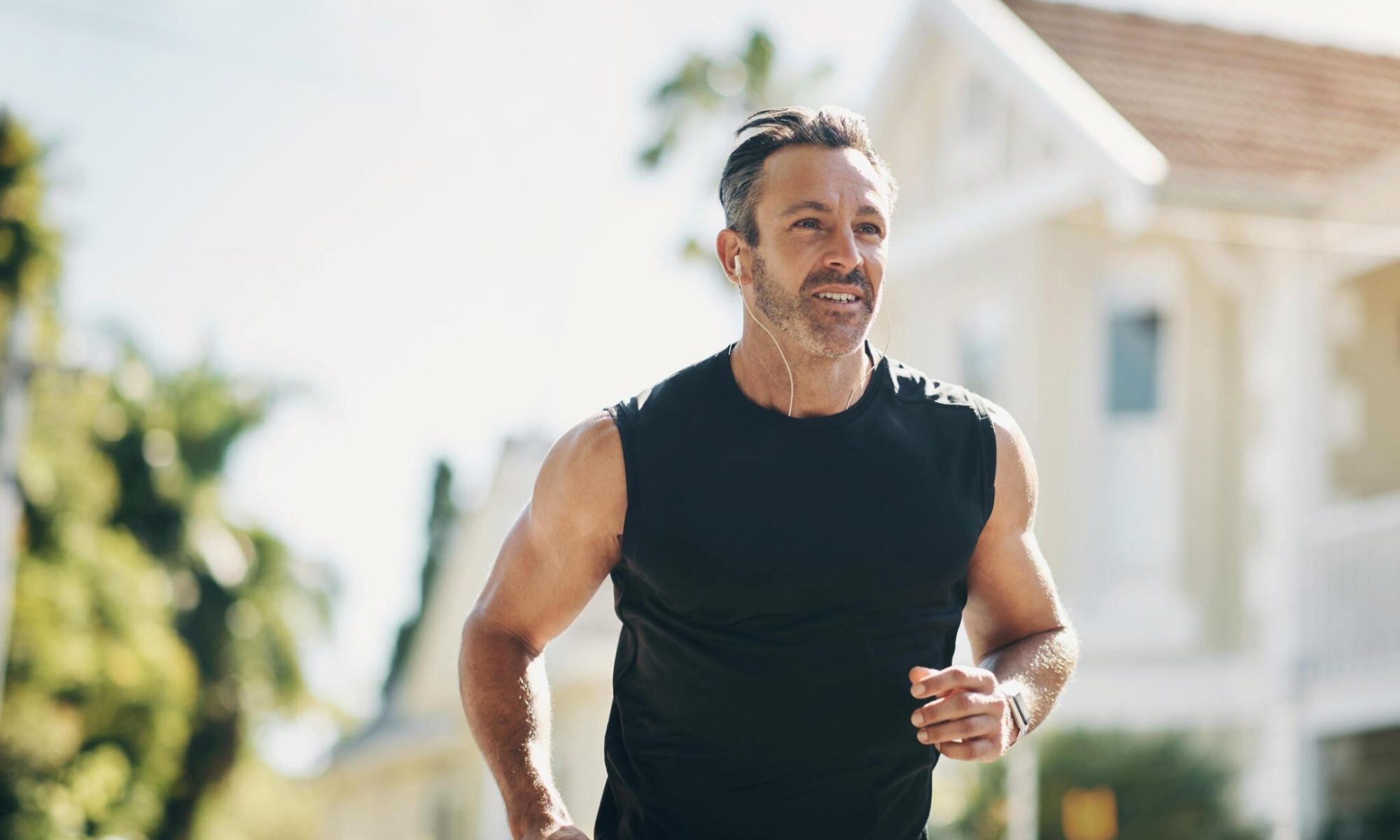
For many individuals, especially men over 30, maintaining a high level of physical fitness becomes increasingly challenging, not just because of the natural aging process but also due to changes in hormone levels. Testosterone, often associated with male virility and vitality, plays a crucial role not just in sexual health but also in muscle mass, fat distribution, and energy levels. Understanding the relationship between testosterone and exercise can open new avenues to achieving and maintaining optimal physical fitness, especially when considering the potential benefits of testosterone replacement therapy for those diagnosed with low testosterone levels.
Table of Contents
Functions of Testosterone in the Body
How Exercise Boosts Testosterone
How Testosterone Replacement Therapy Aids Your Fitness Routine
Best Practices to Balance Testosterone Replacement Therapy and Exercise
How to Tell if Testosterone Replacement Therapy is Worth Trying
FAQ Section
Key Takeaways
|
Functions of Testosterone in the Body
Testosterone, often dubbed the “male hormone,” plays a crucial role in both men and women. Its influence spans from the physical to the psychological, impacting everything from muscle composition to mood regulation.
Fat Distribution Control
Testosterone significantly influences how and where fat is stored in the body. Higher testosterone levels promote a leaner body composition by inhibiting fat storage, particularly around the abdomen. This contributes to a more desirable physique and lowers the risk of conditions associated with excess abdominal fat, such as cardiovascular disease and type 2 diabetes.
Muscle Mass Creation
One of testosterone’s most celebrated roles is facilitating muscle growth. It enhances muscle protein synthesis, a critical process in muscle mass creation and repair. This is why individuals with higher testosterone levels often find it easier to gain and maintain muscle mass, which is a key factor in physical fitness and metabolic health.
Strength Development
The development of physical strength is closely tied to muscle mass. Testosterone’s impact on muscle fibers increases their size and strength, enabling more powerful and effective muscle contractions. This increase in strength is crucial for athletes and maintaining functional daily activities, especially as one age.
Bone Mass Maintenance
Testosterone plays a vital role in bone density and health, helping to prevent osteoporosis and bone fractures. It stimulates bone mineralization and influences bone turnover, ensuring the skeletal system remains strong and resilient against physical stress and aging.
Red Blood Cell Production
The hormone aids in the bone marrow’s production of red blood cells, enhancing oxygen transport throughout the body. This increased oxygen delivery supports various bodily functions, including improving athletic performance and aiding in recovery from physical exertion.
Sex Drive Regulation (Libido)
Testosterone is well known for its ability to regulate sex drive or libido. In both men and women, adequate levels of testosterone are essential for a healthy sex drive, contributing to overall sexual health and well-being.
Sperm Production
In men, testosterone is critical for sperm production, a process known as spermatogenesis. It ensures the development of healthy sperm, which is vital for fertility. Low testosterone levels can decrease sperm count and quality, affecting reproductive capabilities.
How Exercise Boosts Testosterone

Exercise, especially when intense and consistent, directly impacts testosterone levels. Physical activity stimulates the hypothalamus and pituitary gland, which signals the testes to increase testosterone production. The type, intensity, and duration of exercise play pivotal roles in this hormonal response.
A study found significant increases in testosterone levels immediately after resistance training, including high-intensity sessions, illustrating the acute hormonal response to exercise.
Here are six testosterone-boosting exercises to try:
1. Squats
Squats engage multiple large muscle groups, including the quadriceps, hamstrings, and glutes. This compound movement is particularly effective in stimulating testosterone production. Leg workouts and squats, in particular, can lead to robust increases in testosterone levels.
2. Deadlifts
Like squats, deadlifts are powerful compound exercises targeting the lower back, glutes, and legs. They demand a significant hormonal response, and heavy deadlifts can trigger short-term spikes in testosterone levels.
3. Bench Press
The bench press, another compound exercise, focuses on the chest, shoulders, and triceps. It contributes to higher acute testosterone levels post-workout, especially when performed with heavy weights and low repetitions.
4. High-Intensity Interval Training (HIIT)
HIIT involves short bursts of intense exercise followed by rest or low-intensity periods. This form of training can significantly increase testosterone levels. Men engaging in HIIT often experience a noticeable increase in testosterone compared to those performing steady-state endurance exercises.
5. Olympic Lifts
Exercises like the clean, jerk, and snatch are dynamic and involve multiple muscle groups and joints. These movements produce significant increases in testosterone, likely due to the high intensity and total body engagement required.
6. Sprint Intervals
Sprinting, especially in short, intense bursts, has been associated with acute increases in testosterone levels. Short, high-intensity sprints could elevate testosterone levels immediately following the exercise.
How Testosterone Replacement Therapy Aids Your Fitness Routine
Balancing hormones can be as crucial as diet and exercise in pursuing fitness and health. Testosterone replacement therapy in Newtown, CT, aids those facing the challenges of low testosterone levels. Understanding how testosterone replacement therapy can integrate into and enhance your fitness routine is key to unlocking its full potential.
By elevating testosterone levels to a normal range, testosterone replacement therapy aims to alleviate symptoms associated with low testosterone, such as fatigue, muscle loss, and decreased libido, thereby improving the overall quality of life.
Here are different ways testosterone replacement therapy can aid in your fitness routine:
Increased Muscle Mass
Testosterone replacement therapy can significantly enhance muscle protein synthesis, increasing muscle mass and strength. This makes seeing results from resistance training and bodybuilding exercises easier, as the body becomes more efficient at converting effort into muscle.
Enhanced Fat Loss
By optimizing testosterone levels, testosterone replacement therapy can shift the body’s composition, favoring fat loss over muscle loss. Testosterone plays a role in regulating fat distribution and metabolism, helping to increase the rate at which the body burns fat, even during periods of rest.
Improved Recovery Times
Recovery is vital to any fitness routine. Elevated testosterone levels can reduce muscle recovery time, allowing more frequent and intense workouts. Testosterone replacement therapy can thus help you get back to your training regimen quicker, enhancing endurance and performance.
Increased Energy Levels
Low testosterone often results in fatigue and a lack of motivation. Testosterone replacement therapy can counter these effects by boosting energy levels, making it easier to commit to and enjoy regular exercise. With more energy, workouts can become both more consistent and effective.
Enhanced Endurance
Testosterone has been shown to play a role in red blood cell production, which is crucial for oxygen transport throughout the body. Improved oxygenation can enhance endurance, allowing longer, more intense exercise sessions without quick fatigue.
Improved Mood and Cognitive Function
Exercise is not just a physical activity but also a mental one. Testosterone improves mood and cognitive functions, such as focus and motivation, essential for a successful fitness routine. Testosterone replacement therapy can help you stay mentally sharp and motivated towards your fitness goals.
Best Practices to Balance Testosterone Replacement Therapy and Exercise
Integrating testosterone replacement therapy with an exercise routine requires careful consideration to maximize benefits and minimize potential risks. Here are eight key items to consider for those looking to balance testosterone replacement therapy and exercise effectively:
Consult With Healthcare Professionals
Before starting testosterone replacement therapy or any new exercise program, consult with healthcare professionals. A doctor specializing in hormone therapy like those from BioRestore can provide personalized advice on testosterone replacement therapy, while a fitness expert can create an exercise program that fits your needs, ensuring both are aligned for optimal health outcomes.
Tailor Your Exercise Program
Not all exercise routines are created equal, especially when on testosterone replacement therapy. Work with a fitness professional to design a program that complements your therapy, focusing on exercises that maximize muscle growth, fat loss, and cardiovascular health without overtaxing your body.
Monitor Hormone Levels Regularly
Testosterone replacement therapy requires careful monitoring to maintain hormone levels within the optimal range. Regular blood tests will help adjust your testosterone replacement therapy dosage as needed and ensure that your exercise routine supports, not hinders, your hormonal balance.
Prioritize Nutrition
Nutrition plays a crucial role in the effectiveness of testosterone replacement therapy and exercise performance. A diet rich in lean proteins, healthy fats, and complex carbohydrates can support muscle growth and energy needs, while specific nutrients like zinc and vitamin D can further support testosterone levels.
Get Enough Rest
Adequate rest is essential for muscle repair and growth, particularly when on Testosterone Replacement Therapy. Ensure your exercise routine includes sufficient rest days and consider integrating recovery techniques such as stretching, foam rolling, and adequate sleep to enhance recovery and performance.
Stay Hydrated
Hydration is crucial for overall health and can impact testosterone replacement therapy and exercise performance. Drinking enough water supports metabolic processes, including hormone production and regulation, and helps prevent fatigue and overheating during workouts.
Manage Stress Levels
Chronic stress can negatively affect testosterone levels and diminish the benefits of testosterone replacement therapy. Incorporate stress-reduction techniques such as mindfulness, meditation, or yoga into your routine to support hormonal balance and enhance overall well-being.
Do Not Overdo Training
While regular exercise is beneficial, too much can be detrimental, especially when on testosterone replacement therapy. Overtraining can lead to elevated cortisol levels, which may counteract testosterone’s effects. Listen to your body, and if signs of overtraining emerge, such as prolonged fatigue or decreased performance, consider scaling back your workout intensity or frequency.
How to Tell if Testosterone Replacement Therapy is Worth Trying

Deciding whether testosterone replacement therapy is the right choice involves understanding its benefits and weighing them against potential risks. If you’re considering testosterone replacement therapy, here are six key indicators to help you make an informed decision.
You’re Experiencing Fatigue
If you find yourself constantly exhausted despite adequate rest and a healthy lifestyle, it could signal that your testosterone levels are lower than they should be. This fatigue often feels unshakeable and can significantly impact your daily functioning and quality of life.
Your Libido Has Noticeably Decreased
A decline in sexual desire is another common symptom of low testosterone. Suppose you’ve noticed a significant drop in your interest in sexual activity, which is not related to other factors like stress or relationship issues. In that case, it might be time to explore Testosterone Replacement Therapy. This reduction in libido is often accompanied by other sexual health issues, such as erectile dysfunction, further indicating that low testosterone could be the culprit.
You’re Experiencing Mood Swings and Mental Health Issues
Low testosterone can have a profound impact on your mental health, leading to mood swings, irritability, depression, and difficulty concentrating. If these symptoms are new to you or have worsened without apparent cause, they might be related to hormonal imbalances. Men who experience these mental health challenges, in conjunction with other symptoms of low testosterone, may find relief through Testosterone Replacement Therapy.
Physical Changes Are Evident
Physical signs can be some of the most noticeable indicators that Testosterone Replacement Therapy might be worth undergoing to. These include increased body fat, especially around the waist, reduced muscle mass even with regular exercise, and weakened bone density, which makes you more prone to fractures. If you’re observing these changes in your body and can’t attribute them to changes in your fitness routine or diet, it could be a sign of low testosterone.
You Have Difficulty with Memory and Concentration
Testosterone plays a role in cognitive functions, including memory and concentration. If you find it increasingly difficult to focus or remember things and these issues aren’t related to aging or stress, low testosterone levels could be a contributing factor. Men who notice a decline in their cognitive abilities alongside other symptoms of low testosterone might consider Testosterone Replacement Therapy as a way to alleviate these concerns.
Remember, the best way to know if TRT is for you is through a thorough health evaluation by a healthcare provider. They can assess your symptoms, medical history, and lifestyle factors to determine if testosterone replacement therapy is appropriate. Keep in mind that certain health conditions can be exacerbated by testosterone replacement therapy, such as sleep apnea, prostate enlargement, and cardiovascular issues.
FAQ Section
Can exercise alone boost testosterone to optimal levels?
Exercise, particularly resistance training and high-intensity interval training (HIIT), has been shown to elevate testosterone levels. These activities stimulate muscle growth and cardiovascular health, increasing natural testosterone. However, for individuals with clinically diagnosed low testosterone (hypogonadism), exercise alone may not be sufficient to bring testosterone levels back to an optimal range. Testosterone replacement therapy may be necessary to achieve hormonal balance and support overall health and fitness goals.
Are there any side effects of combining testosterone replacement therapy with an exercise routine?
Combining testosterone replacement therapy with an exercise routine is generally considered safe under the guidance of healthcare professionals. It’s important, though, to be aware of potential side effects associated with testosterone replacement therapy, such as acne, mood swings, and changes in cholesterol levels. Regular check-ups and blood tests can help monitor these effects.
How long does it take to see results from testosterone replacement therapy in my fitness routine?
The timeline for seeing results from testosterone replacement therapy can vary based on individual health factors, the specific regimen followed, and the consistency of both the testosterone replacement therapy and exercise routine. Generally, increased energy levels and improved mood can be noticed within the first few weeks. More tangible results, such as enhanced muscle growth and fat loss, might take several months to become evident. Consistency and patience are key, as the body needs time to adjust to hormonal changes and translate these into physical improvements.
Is testosterone replacement therapy a shortcut to achieving fitness goals?
Viewing testosterone replacement therapy as a shortcut to fitness goals is a misconception. While it can support individuals with low testosterone levels in achieving better exercise performance, muscle growth, and fat loss, it works best as part of a comprehensive approach that includes a balanced diet, regular exercise, and healthy lifestyle choices.
How does testosterone replacement therapy impact long-term health?
Concerns about the long-term risks of testosterone replacement therapy have been raised and Individuals on testosterone replacement therapy must undergo regular monitoring and medical evaluations to manage these risks effectively and ensure that the therapy continues to align with their health and fitness objectives.
Explore Testosterone Replacement Therapy with BioRestore Today!

Understanding how testosterone replacement therapy can complement your fitness routine is crucial for those considering this therapy. With the right approach, testosterone replacement therapy can enhance your exercise outcomes, improve your health, and elevate your overall quality of life. For expert guidance and personalized testosterone therapy plans, trust BioRestore in Newtown, CT. Our team is dedicated to helping you achieve your health and fitness goals. Contact us today to discover how we can support your journey to wellness!